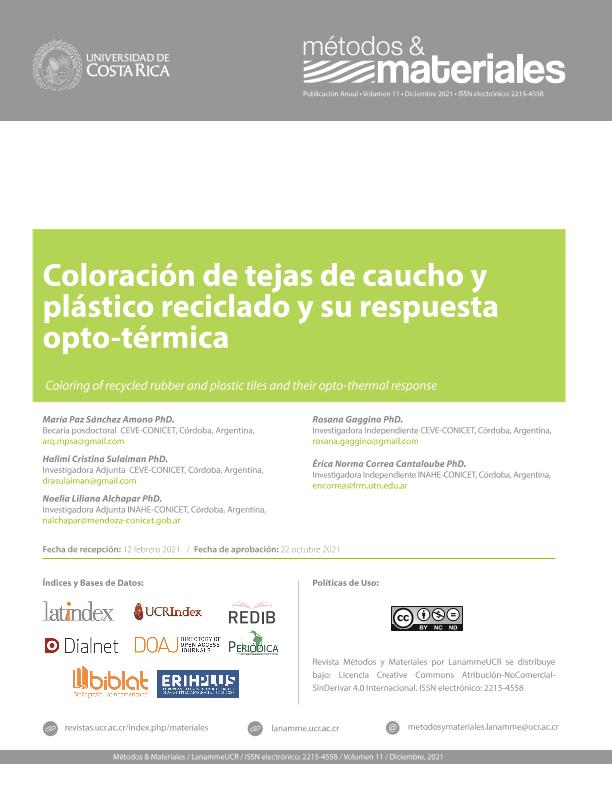Artículo
La eficiencia energética consiste en lograr un menor consumo de energía frente a una misma prestación. La distinta cantidad de radiación solar que es reflejada o absorbida se debe al color de la superficie. Las tejas desarrolladas en esta investigación son de color negro, por tener partículas de caucho en su composición, que contienen negro de humo. Los colores oscuros tienen una absortividad solar mayor, por lo tanto, se analizó la alternativa de colorear las tejas con colores claros, para reducir la absorción de radiación solar. El objetivo es evaluar distintas posibilidades técnicas para la coloración de tejas a partir de la incorporación de pigmentos, y determinar el rendimiento energético. Para la fabricación, se incorporaron óxidos, masterbatch, caucho y polietileno de color. Se realizaron experiencias variando sus dosificaciones y para la determinación del comportamiento termo-físico de las tejas se testearon propiedades ópticas (albedo y emisividad) y temperatura superficial de 2 unidades muestrales -una teja coloreada en verde y una en negro-. El grupo con mejores resultados fue el número 3, donde se mezcla el caucho negro, el polietileno verde y el masterbatch. Al comparar el desempeño termo-físico de tejas recicladas color verde en relación a tejas color negro, se observó un comportamiento más eficiente en las tejas de color verde. Se registraron incrementos en el nivel de albedo del 11% y disminuciones de temperatura superficial superior a 8°C. Energy efficiency consists of achieving lower energy consumption compared to the same benefit The different amount of solar radiation that is reflected or absorbed is due to the surface color. The tiles developed in this research are black, as they have rubber particles in their composition, which contain carbon black. Dark colors have a higher solar absorptivity, therefore, the alternative of coloring the tiles with light colors was analyzed, to reduce the absorption of solar radiation. The objective is to evaluate different technical possibilities for laying tiles from the incorporation of pigments, and to determine the energy efficiency. For manufacturing, colored oxides, masterbatch, rubber and polyethylene were incorporated. Experiments were carried out varying their dosages and for the determination of the thermo-physical behavior of the tiles, optical properties (albedo and emissivity) and surface temperature of 2 sample units were tested -one tile colored in green and one in black-. The group with the best results was number 3, where black rubber, green polyethylene and masterbatch were mixed. When comparing the thermo-physical performance of recycled green tiles in relation to black tiles, a more efficient behavior was observed in green tiles. Increases in the albedo level of 11% and decreases in surface temperature greater than 8 ° C were recorded
Coloración de tejas de caucho y plástico reciclado y su respuesta opto-térmica
Título:
Coloring of recycled rubber and plastic tiles and their opto-thermal response
Sanchez Amono, Maria Paz ; Sulaiman, Halimi Cristina
; Sulaiman, Halimi Cristina ; Alchapar, Noelia Liliana
; Alchapar, Noelia Liliana ; Gaggino, Rosana
; Gaggino, Rosana ; Correa Cantaloube, Erica Norma
; Correa Cantaloube, Erica Norma
 ; Sulaiman, Halimi Cristina
; Sulaiman, Halimi Cristina ; Alchapar, Noelia Liliana
; Alchapar, Noelia Liliana ; Gaggino, Rosana
; Gaggino, Rosana ; Correa Cantaloube, Erica Norma
; Correa Cantaloube, Erica Norma
Fecha de publicación:
12/2021
Editorial:
Universidad de Costa Rica
Revista:
Métodos & Materiales
ISSN:
2215-4558
e-ISSN:
2215-4558
Idioma:
Español
Tipo de recurso:
Artículo publicado
Clasificación temática:
Resumen
Palabras clave:
RECICLADOS
,
TEJAS
,
COLORACIÓN
,
COMPORTAMIENTO TERMO-FÍSICO
Archivos asociados
Licencia
Identificadores
Colecciones
Articulos(CEVE)
Articulos de CENTRO EXPERIMENTAL DE LA VIVIENDA ECONOMICA(I)
Articulos de CENTRO EXPERIMENTAL DE LA VIVIENDA ECONOMICA(I)
Articulos(INAHE)
Articulos de INSTITUTO DE AMBIENTE, HABITAT Y ENERGIA
Articulos de INSTITUTO DE AMBIENTE, HABITAT Y ENERGIA
Citación
Sanchez Amono, Maria Paz; Sulaiman, Halimi Cristina; Alchapar, Noelia Liliana; Gaggino, Rosana; Correa Cantaloube, Erica Norma; Coloración de tejas de caucho y plástico reciclado y su respuesta opto-térmica; Universidad de Costa Rica; Métodos & Materiales; 11; 12-2021; 1-10
Compartir
Altmétricas



